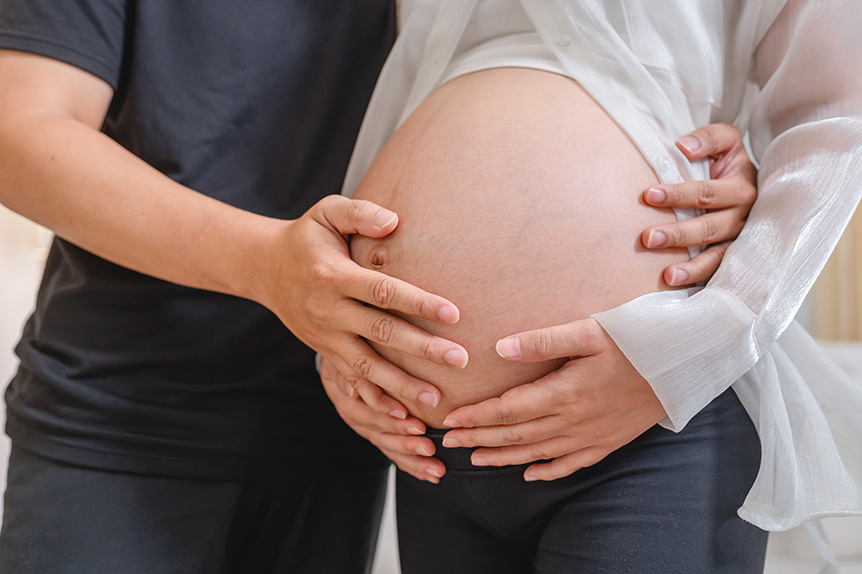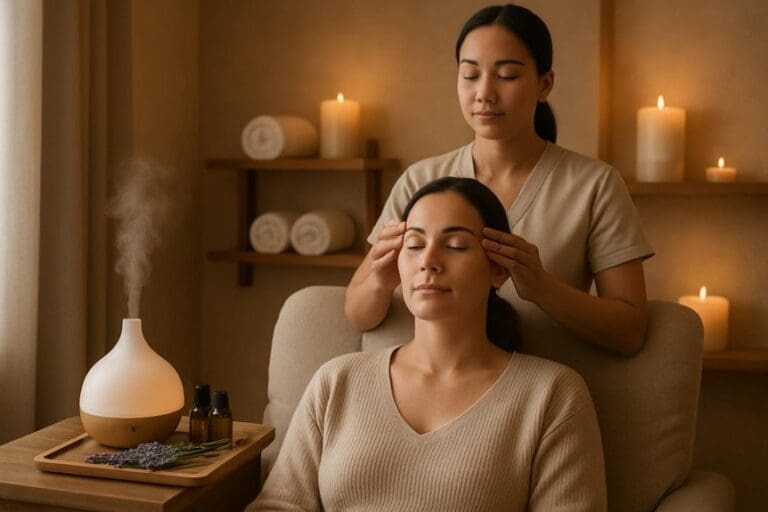Yes—gentle, superficial breast massage during pregnancy is generally safe when firm pressure, nipple stimulation, and painful areas are avoided. Short sessions in a semi‑reclined or side‑lying position with neutral, unscented oil are recommended. It may ease congestion, tenderness, and swelling while supporting comfort and circulation. Stop if contractions, dizziness, warmth/redness, or sharp pain occur, and seek advice with high‑risk pregnancies or new lumps. Avoid arousal-focused nipple stimulation early in pregnancy. Further guidance covers step‑by‑step techniques and safety tips.
Is Breast Massage Safe During Pregnancy?
While breast massage can be appropriate during pregnancy, safety depends on technique, timing, and individual comfort. From Spa & Massage’s clinical perspective, gentle, superficial touch around the breast and chest wall is generally safe when avoiding firm pressure, nipple stimulation, and any painful areas.
Evidence-informed practice emphasises slow strokes, open communication, and stopping if tenderness, contractions, or dizziness occur.
In our clinics, therapists recommend neutral, unscented or lightly fragranced pregnancy-safe oils, short sessions, and side-lying positions that protect the bump.
Partners can participate with consent-led touch, focusing on relaxation rather than manipulation.
Avoid deep pressure over ducts, the armpit, and any lumps; report new changes to a midwife.
If there is a high-risk pregnancy, consult a clinician first.
Comfort, consent, and caution guide safety.
Many principles of deep tissue massage—such as using appropriate pressure and being mindful of sensitive areas—are relevant when considering any massage during pregnancy, but for breast massage, only gentle techniques should be used.
Benefits of Gentle Breast Massage for Expectant Mums
Gentle breast massage during pregnancy can help reduce discomfort and tenderness by easing tissue congestion and supporting skin elasticity.
Light, slow strokes may promote superficial circulation, which is associated with healthy breast tissue and can support lactation readiness without stimulating the nipple excessively.
At Spa & Massage, therapists educate partners on safe, minimal-pressure techniques and timing to maximise comfort while maintaining a cautious, clinically informed approach.
Comfort and Tenderness
Although breast tissue can be particularly sensitive in pregnancy, evidence and clinical experience indicate that light, well‑paced touch can reduce tenderness, improve comfort, and support healthy circulation in the chest wall.
In Spa & Massage clinics, therapists advise partners to use a feather‑light glide with open palms, moving around the breast mound and along the pectoral area, while avoiding direct pressure on the nipple and any painful spots.
Unscented, hypoallergenic oils are preferred; many clients choose a small amount to minimise friction and enhance soothing contact.
Consistency matters. Short sessions of two to five minutes, a few times per week, often ease achiness linked to tissue growth and postural strain.
Slow breathing together can regulate pressure and rhythm, preserving intimacy while maintaining safety and comfort.
Circulation and Lactation
Building on comfort-focused touch, attention to circulation offers additional benefits for expectant mums. Gentle, pain-free breast massage can support healthy blood and lymph flow, helping reduce swelling, tenderness, and congestion that often accompany hormonal changes.
Evidence suggests improved circulation may aid tissue elasticity and comfort, and, closer to birth, may support early colostrum movement without stimulating labour when performed lightly and briefly.
From Spa & Massage’s clinical perspective, partners can use slow, superficial strokes around the breast and chest wall, avoiding deep pressure and the nipple in the first and second trimesters.
In late pregnancy, brief, soft circular motions around the areola may assist comfort. Our therapists recommend hypoallergenic, unscented oils, five to seven minutes per side, and immediate stop with pain, contractions, leakage, or dizziness, consulting a midwife if uncertain.
When to Avoid Breast Massage and Red Flags to Watch
Spa & Massage advises caution with breast massage in the first trimester and recommends avoiding it entirely if there is any unexplained pain, nipple bleeding, or new lumps.
Red flags such as fever, warmth, redness, swelling, or streaking may indicate infection or mastitis and warrant prompt medical review before any touch.
Their therapists encourage clients to pause massage and seek assessment if symptoms change suddenly or feel atypical for pregnancy.
First-Trimester Cautions
When is it safest to proceed? In the first trimester, gentle touch is acceptable if there is no pain, bleeding, cramping, or pregnancy complications. Spa & Massage advises partners to prioritise comfort, consent, and very light pressure only—think soothing strokes over the breast surface, avoiding deep kneading.
If nausea is strong, wait for a time of day she feels well.
Red flags that pause any breast massage include vaginal bleeding, severe breast pain, new unilateral lumps, fever, pronounced nipple discharge with blood, dizziness, faintness, or a history of miscarriage or IVF—seek clinician guidance first.
Avoid nipple stimulation intended to trigger arousal or milk let-down; oxytocin release can increase uterine activity early on.
Use neutral, hypoallergenic oil; in our clinics, therapists recommend unscented options to reduce sensitivity.
Infection or Mastitis Signs
Beyond early-trimester cautions, infection risk warrants particular attention before any breast touch. If mastitis or skin infection is suspected, massage should pause until cleared by a clinician.
Red flags include a new, localized area of warmth with redness, swollen skin that feels tight, a tender wedge-shaped patch, fever or flu-like malaise, thickened skin or shiny streaking, and nipple discharge that is pus-like or foul-smelling. Cracked nipples with increasing pain or heat also merit caution.
From Spa & Massage’s clinical perspective, gentle intimacy is safest when tissue is healthy. Partners should use clean hands, avoid pressing painful zones, and keep touch light and non-irritating.
In our clinics, therapists recommend fragrance-free, hypoallergenic oils and stopping immediately if warmth, redness, or systemic symptoms appear. Seek prompt medical advice.
Pain, Lumps, or Bleeding
A sudden increase in breast pain, a new or growing lump, nipple bleeding, or bloody discharge are clear signals to pause any partner massage and seek clinical assessment.
During pregnancy, hormonal changes can make breasts tender and nodular; however, escalating pain, a firm fixed mass, warmth with redness, or bleeding require prompt review by a midwife, GP, or breast clinic.
Until assessed, partners should avoid direct pressure, deep kneading, or nipple stimulation.
At Spa & Massage, therapists advise couples to prioritise comfort and safety: use light, superficial strokes around the chest wall and shoulders only when there are no red flags.
If cleared by a clinician, gentle touch with neutral, unscented oil may resume, keeping communication open, pressure minimal, and sessions brief.
How Your Partner Can Massage Safely: Step-by-Step Guidance
Before starting, partner massage should prioritise comfort, consent, and gentle technique. Spa & Massage recommends a quiet room, supportive pillows, and a warm, clean towel. The pregnant person chooses position—semi‑reclined or side‑lying—to reduce strain. A brief check-in defines boundaries: where to touch, where to avoid, and when to stop.
Begin with warm hands. Place relaxed palms over the chest wall, not the nipple, and breathe together to settle pace. Use light, circular strokes around the breast tissue, moving from outer chest toward the underarm to follow natural lymph pathways. Avoid deep pressure and any areas of pain, redness, heat, or discharge.
Finish with slow, supportive holds over the upper chest and shoulders. Reassess comfort, hydrate, and stop if tenderness increases.
Oils and Touch Pressure Our Therapists Recommend
With positioning and boundaries established, attention turns to what goes on the skin and how much pressure to use. At Spa & Massage, therapists prefer light, neutral emollients for the breast and chest wall—typically cold-pressed sweet almond or fractionated coconut oil—because they glide well, absorb cleanly, and are generally well tolerated. Fragrance-free options are recommended in pregnancy.
A small patch test on the inner arm is prudent, especially for sensitive skin.
Pressure should remain gentle to light: no deeper than the sensation of moving skin over tissue, not compressing into muscle. Partners are advised to use flat, open palms, slow strokes, and avoid direct pressure over nipples or any tender areas.
Any sharp discomfort, heat, or swelling signals stopping and reassessing comfort together.
Supporting Breast Changes, Tenderness, and Lymphatic Flow
Gently managed touch can help relieve the normal breast changes of pregnancy—tenderness, heaviness, and occasional swelling—while supporting lymphatic flow. From Spa & Massage’s clinical perspective, slow, superficial strokes that move from the nipple area outward toward the axillae (armpits) align with lymph pathways and can reduce fluid congestion.
Pressure should remain light, avoiding deep kneading over glandular tissue. Circular, fingertip motions around the outer breast, paired with gentle sweeping strokes toward the underarm, are well tolerated.
Therapists advise short sessions—5 to 10 minutes—on each side, with breathable, unscented oil to minimise friction. Warm hands, steady rhythm, and communication about comfort foster relaxation and intimacy.
Any sharp pain, redness, heat, or focal lumps warrants pausing touch and noting changes for discussion at routine antenatal care.
When to Seek Professional Support at Spa & Massage London
Clear indicators suggest when professional input is appropriate. Persistent breast pain, pronounced swelling asymmetry, localised heat, redness, or peau d’orange changes warrant prompt assessment.
Nipple discharge that is bloody or foul-smelling, new palpable lumps, or worsening tenderness despite gentle home care also justify professional support. During pregnancy, fever, mastitis history, or prior breast surgery further increases the need for expert guidance.
At Spa & Massage London, therapists trained in pregnancy care use light, lymphatic-informed techniques around the chest wall, neck, and shoulders—never direct breast manipulation—aiming to ease congestion, improve posture, and calm the nervous system.
They coordinate with medical advice and adjust positioning to protect maternal circulation. Clients receive guidance on partner touch: pressure, direction, and duration that remain safe, comfortable, and intimate, with aftercare to reduce sensitivity and support restful connection.
Conclusion
In pregnancy, tenderness meets reassurance: evidence supports gentle, informed breast massage while caution tempers enthusiasm. When light pressure, neutral positioning, and natural oils are used, comfort can rise and lymphatic flow may improve; when pain, discharge changes, or infection signs appear, touch should pause and care be sought. Partner support offers warmth; professional guidance guarantees safety. Between intimate connection and clinical prudence, the best path is clear communication, consent, and adaptation—nurturing wellbeing without crossing the body’s evolving boundaries.



